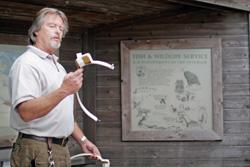
Matt Moore
There weren’t any Red Wolves in North Carolina in early 1987.
That was before the Red Wolf Recovery Team, based at the state’s coast between Alligator River and the Intracoastal Waterway, took in eight red wolves that were scattered throughout Florida and Texas.
“In 1987, there were no Red Wolves in the wild,” Michael Morse, a wildlife biologist who works with the Red Wolf Recovery Team, said. “They were declared extinct. … [Early in that year], we got all the remaining Red Wolves from the wild. Now, this is the only place Red Wolves exist in the wild.”
And they’re not just living, they’re living well. Most of the wolves are healthy, Morse said — they have 1.7 million acres to roam through, other wolves to establish packs with, and a group of people who are working toward keeping their population high. The population stands at more than 130, according to “International Wolf,” a publication of the International Wolf Center.
Graduate students in the College of Veterinary Medicine are part of this group. The veterinary students surgically sterilize coyotes, the only natural enemy to Red Wolves, so high coyote populations do not overwhelm and kill the wolves.
It’s a more humane option, Morse said, because the only other choice they have to protect the wild Red Wolf population is to kill off local coyotes.
Controlling coyote populations also limits interbreeding between the Red Wolves and coyotes, an act that “creates a vacuum whether other coyotes can move in.”
Tracking their movementsThe Recovery Program uses collars to track the wolves’ movements between 8 and 10 a.m., when program workers are able to fly above the forest and scan for collars.
“After that time, it’s up in the air.”
That’s when those working with the program have to go out “on the ground” and look for signs — like scat — of their diets, gene pool, species and roaming habits, according to information written by Diane Hendry, the Red Wolf Recovery Team’s outreach coordinator.
There is another option. It’s more efficient, yet more costly. A collar enabled with a Global Positioning System can track the wolves at all time.
They put these $4,000 collars (the original collars cost $350 each) on yearlings before they leave the pack.
“GPS collars show you everything,” Morse said. “We’ve been blown out of the water by how much these wolves will travel to find their territories.”
Those who move out too far from the reserved area, Morse said, are more likely to be killed, either by cars, because they are separating from the pack, or by hunters.
“But once they reestablish themselves,” he said, “the mortality rate settles down.”
This is what a Wolfpack isThe Wolfpack is a closely knit group of wolves that moves together, hunts together and lives together.
“The male and the female mate for life,” Morse said. “That’s basically how the Wolfpack works.”
And the ideas of the “lone wolf” and the “big bad wolf,” Morse said, is almost improbable.
“You just don’t have a lot of lone wolves,” he said.
That’s because, once a Wolfpack establishes itself, members rarely stray from one pack to another. Although cubs leave once they grow old enough to find mates, Morse said cubs will often come back to the original pack five to six times before leaving forever.
“Once that family unit is in place, it’s tight,” Morse said.